Pulpectomy
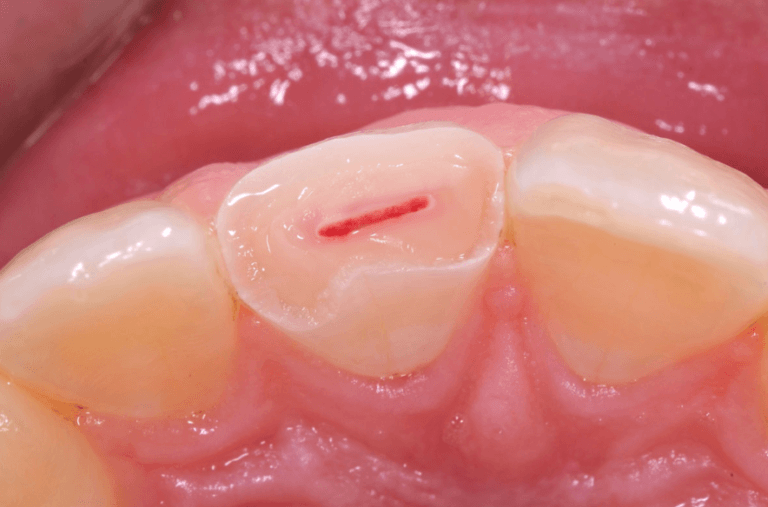
What Is Pulpectomy?
The pulp tissue, located at the center of the tooth, houses nerves and blood vessels, contributing to the tooth’s overall vitality. When this pulp tissue becomes infected with bacteria or is damaged, a procedure like Pulpectomy is necessary. Pulpectomy removes all the pulp tissue from the crown and roots of a tooth, replacing it with a temporary sedative material that can be reabsorbed by the body. A pulpectomy can be done alone on a temporary, emergency basis to alleviate pain and halt the spread of infection. It is often done as the first step in the Root Canal Treatment procedure.
Before deciding on whether Pulpectomy are right for you, there are some things you should know:
- Who Needs A Pulpectomy?
- What Are The Indications For Pulpectomy?
- Benefits Of A Pulpectomy
- Alternative Treatments To Pulpectomy
- How Much Does Pulpectomy Cost?
- Steps In The Pulpectomy Procedure
- Frequently Asked Questions About Pulpectomy
If you have any further questions about Pulpectomy or other dental services offered at Atlas Dental, please contact us.

Free phone consultation
Have questions about Pulpectomy? Schedule a free phone consultation with our Toronto dentist.

5 star google reviews
Our patients love us! See for yourself why more and more people are choosing Atlas Dental for Pulpectomy

Book emergency pulpectomy
Do you think you have cavities and need a Pulpectomy? Book an emergency Pulpectomy online.
Who Needs A Pulpectomy?
Understanding the situations that require pulpectomy can help you recognize when to seek dental care. Common reasons include:
- Deep Tooth Decay: When tooth decay extends deep into the pulp, it can cause infection and inflammation. In such cases, a pulpectomy is often recommended to remove the infected pulp and prevent the spread of bacteria.
- Trauma or Injury: Accidents or injuries to the tooth can lead to damage in the pulp. Whether due to a sports injury or a fall, trauma may necessitate a pulpectomy to address internal damage and preserve the tooth.
- Abscess Formation: An abscess, a painful collection of pus, can form at the tooth’s root when the pulp is infected. Pulpectomy is often necessary to drain the abscess, eliminate the infection, and save the tooth.
- Cracked or Fractured Tooth: A tooth with a significant crack or fracture may expose the pulp to bacteria, leading to infection. Pulpectomy becomes essential to address the compromised pulp and salvage the tooth.
Early intervention through a pulpectomy can not only alleviate pain and discomfort but also preserve the affected tooth, contributing to overall oral health. If you have further questions about the Pulpectomy treatment, please contact us.
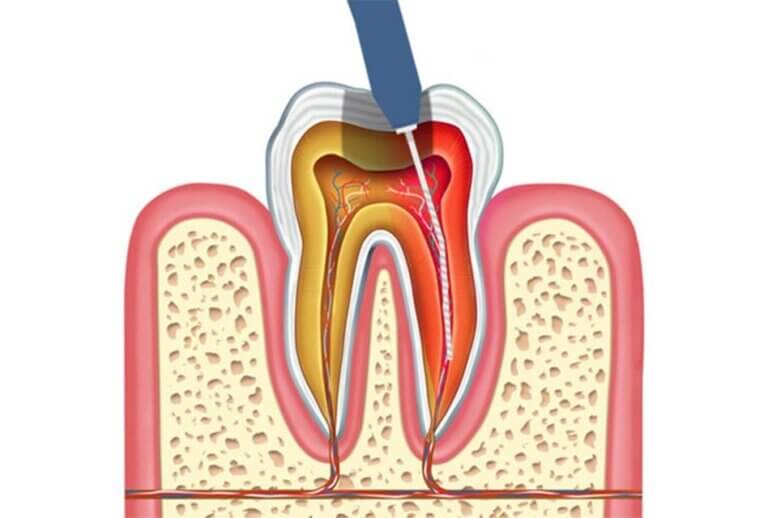
Signs and Symptoms For Pulpectomy
Here are some common signs and symptoms that may prompt a dentist to suggest a pulpectomy:
- Severe Toothache: Persistent and intense toothache, especially when chewing or applying pressure, can indicate an issue deep within the tooth. If the pain is associated with inflammation or infection of the pulp, a pulpectomy may be advised.
- Prolonged Sensitivity: Heightened sensitivity to hot or cold temperatures that lingers even after the stimulus is removed could be a sign of pulp-related problems. If conventional treatments for tooth sensitivity prove ineffective, a pulpectomy might be considered.
- Swelling or Abscess: Swelling in the gums or the development of an abscess (a painful, pus-filled sac) near the affected tooth often signals an infection reaching the pulp. A pulpectomy becomes necessary to eliminate the infection and prevent its spread.
- Discoloration of the Tooth: A tooth that undergoes a change in color, turning gray or dark yellow, may indicate damage or infection in the pulp. Addressing the issue through a pulpectomy can restore the tooth’s appearance and health.
- Cracked or Fractured Tooth: A significant crack or fracture in a tooth may expose the pulp to bacteria, leading to infection. Pulpectomy is often necessary to treat the compromised pulp and save the tooth.
If you are experiencing any of these symptoms, consulting with a dental professional is paramount to determine the most appropriate course of action and preserve your oral health. If you have further questions about the Pulpectomy treatment, please contact us.
Benefits Of A Pulpectomy
Pulpectomy offers several benefits, making it an effective solution for addressing pulp-related dental issues:
- Pain Relief: Eliminates the source of discomfort caused by inflamed or infected pulp.
- Prevention of Infection Spread: Stops the progression of bacterial infection to surrounding tissues.
- Preservation of Natural Tooth: Maintains the tooth structure, preventing complications like shifting teeth or jawbone deterioration.
- Cost-Effective Treatment: Compared to tooth extraction and replacement, pulpectomy is often a more affordable option.
It is crucial for patients to consult with their dentist to determine if a pulpectomy is the most suitable treatment for their individual circumstances. If you have further questions about the Pulpectomy treatment, please contact us.
Alternative Treatments To Pulpectomy
In some cases, alternative treatments may be considered based on the severity of the dental issue:
- Root Canal Therapy: A more comprehensive treatment that permanently cleans, seals, and restores the tooth.
- Direct or Indirect Pulp Capping: For less severe pulp exposure, medicated dressings may protect and heal the pulp.
- Tooth Extraction: If the tooth is beyond repair, extraction followed by replacement options like implants or bridges may be recommended.
Your dentist will carefully evaluate your oral health, consider your preferences, and discuss the pros and cons of each alternative treatment option. If you have further questions about the Pulpectomy treatment, please contact us.
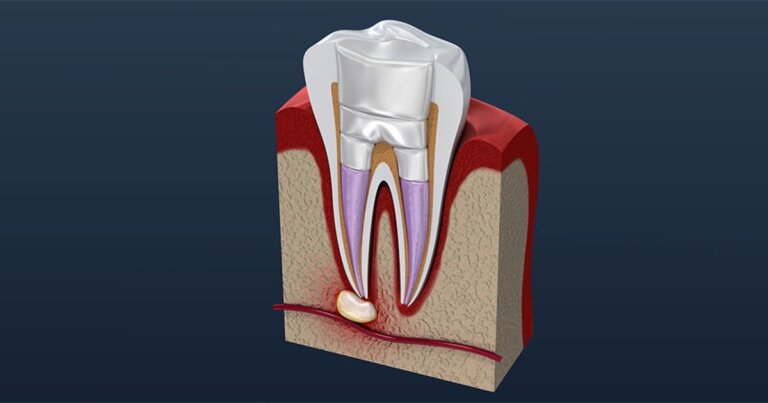
Cost of Pulpectomy
The cost of a Pulpectomy can range between $180-325. It will depend on whether the tooth is a baby tooth or an adult tooth, as well as the number of canals inside the tooth. The codes relevant to pulpectomy in the Ontario Dental Association’s Suggested Fee Guide appear as follows:
Pulpectomy, Permanent Teeth/Retained Primary Teeth
- 32311 – One canal: $180
- 32312 – Two canals: $187
- 32313 – Three canals: $279
- 32314 – Four canals or more: $327
Pulpectomy, Primary Teeth
- 32321 – Anterior Tooth: $180
- 32322 – Posterior Tooth: $187
Pulpectomies are considered a basic service under all dental insurance plans and should be covered to your maximum insurable limit, but be sure to find out from your dental insurance plan provider how much you are eligible for before going ahead with dental treatment. Our fees are consistent with the ODA Fee Guide.
For patients without dental insurance, Atlas Dental is pleased to offer dental financing through iFinance Dentalcard. Affordable payment plans start at 7.95% for terms of 6 months to 6 years. To learn more about Dentalcard dental treatment financing, follow this link.
Steps In The Pulpectomy Procedure
While specific steps may vary based on individual cases and the tooth involved, here is a general overview of the typical steps in a pulpectomy procedure:
- Preparation and Anesthesia: The dentist administers local anesthesia to numb the area and isolates the tooth using a rubber dam to keep it dry and clean.
- Access Opening: An opening is made in the tooth to access the pulp chamber, removing decayed material and old fillings if necessary.
- Pulp Removal and Cleaning: The infected pulp tissue is carefully removed, and the root canals are cleaned, shaped, and disinfected to eliminate bacteria.
- Irrigation and Medication: Sterile solutions flush the canals to ensure thorough disinfection. Medications may be placed to promote healing and prevent further infection.
- Temporary Filling: The tooth is sealed with a temporary filling to protect it until follow-up treatment, such as root canal therapy or permanent restoration, is completed.
Throughout the pulpectomy procedure, dentists prioritize patient comfort and safety. It’s common for patients to experience mild discomfort or sensitivity after the procedure, which can usually be managed with over-the-counter pain medications. If you have further questions about the Pulpectomy treatment, please contact us.
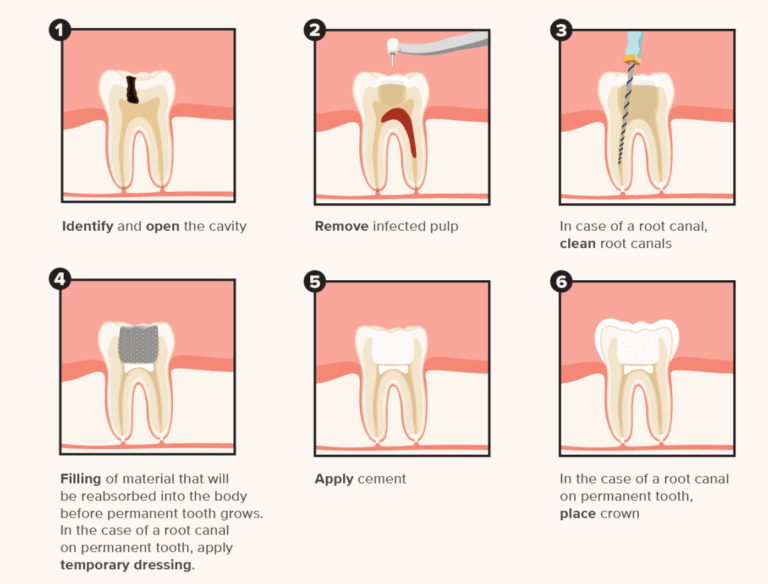
Frequently Asked Questions About Pulpectomy
- Is Pulpectomy Painful?
Pulpectomy is performed under local anesthesia, ensuring a pain-free experience during the procedure. Mild discomfort afterward is normal and can be managed with over-the-counter pain relievers.
- What Happens If I Skip a Pulpectomy?
Delaying or avoiding pulpectomy can lead to severe infections, abscess formation, and tooth loss. The infection may also spread to other parts of the body, causing systemic complications.
- Can Pulpectomy Be Done on Baby Teeth?
Yes, pulpectomy is often performed on primary teeth to treat infections while preserving the tooth until it naturally falls out. This helps maintain proper spacing for permanent teeth.
- What Is the Difference Between Pulpectomy and Root Canal Therapy?
Pulpectomy removes the pulp as a temporary or emergency measure, often as the first step in root canal therapy, which involves cleaning, sealing, and permanently restoring the tooth.
Pulpectomy is a crucial procedure for addressing severe pulp issues and preserving natural teeth. If you’re experiencing dental pain, sensitivity, or other symptoms, contact us at Atlas Dental to schedule an appointment and explore your treatment options.
We also think you’ll like…

Dental Infection
Dental Infection What Is Dental Infection? Are you dealing with a Dental Infection? This painful condition occurs when harmful bacteria infiltrate the tissues in your
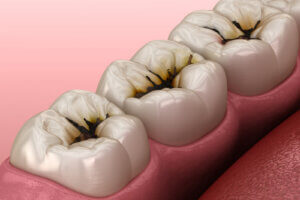
Irreversible Pulpitis
Irreversible Pulpitis What Is Irreversible Pulpitis? Irreversible pulpitis is a condition where the dental pulp—the innermost part of the tooth containing nerves and blood vessels—becomes
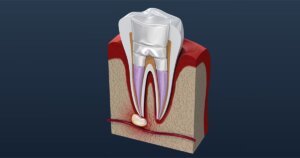
Bioceramic Root Canal Sealers
Bioceramic Root Canal Sealers What Are Bioceramic Root Canal Sealers? Bioceramic root canal sealers are bioactive, non-toxic materials used to seal the root canal system
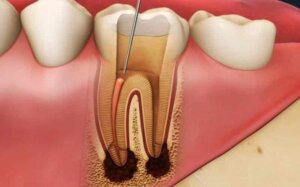
Failed Root Canal Treatment
Failed Root Canal Treatment What Is Failed Root Canal Treatment? Failed root canal treatment occurs when a tooth that has undergone root canal therapy continues

Broken Tooth
Broken Tooth What Is A Broken Tooth? A Broken Tooth occurs when a tooth is chipped, cracked, or fractured. This can result from various causes,

Dental Pain Medication
Dental Pain Medication What Is Dental Pain Medication? Dental pain can be disruptive and overwhelming, turning even simple daily tasks into challenges. For those experiencing

